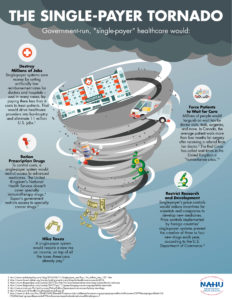Introduction
Introduction of five ‘issues’:
When Wipeout premiered on June 24, 2008, it introduced viewers to a humourous show starring wild obstacle courses designed to fling challengers into mud pools. The show became so popular that it was renewed for seven seasons and spread to include competitors from outside the United States. However, there is a variety of different uses for obstacle courses outside of entertainment. As a matter of fact, obstacle courses are sometimes used as a metaphor to represent the difficulty of achieving a goal. For instance, supporters of single-payer healthcare face several obstacles or issues on the path to federal implementation. Most of these issues, with the exception of one, were summarized by the National Association of Health Underwriters (NAHU) in the image below and then published by Roper Insurance. In detail, the picture titled The Single-Payer Tornado listed five issues of single-payer healthcare. These issues are that single-payer will bankrupt medical providers, restrict access to drugs, raise taxation, increase patient wait times, and restrict research. Each of the aforementioned issues is addressed in detail under the issues tab on the ‘the five issues’ page, but there is one additional issue that is worth mentioning here.

Introduction of the sixth and biggest ‘issue’:
While the five claims listed on the image require address, the worst issue of single-payer healthcare is hidden in the footnotes area of the image. To put it differently, the NAHU pretends to back up their claims in the image by including footnotes with links to seven sources. Nevertheless, their ‘research’ can be nullified without even checking the websites. According to the University of Georgia, the Austin Community College District, and the University of Maryland, “objective information with a listed author and/or presented by a reliable publisher is far more credible than anonymous information published by a commercial or an anonymous source” (1)(2)(3). To clarify, the general research rule states that .gov websites, .edu websites, and critically reviewed scholarly articles are reliable sources of information, while .com websites, .org websites, and blog posts are undependable. Out of the seven sources in the footnotes of the image, only one is a reliable .gov website. To make matters worse, the first URL contains the word blog which clearly indicates that the URL leads to a questionable article. On top of all that, the picture does not mention that the NAHU mainly represents licensed health insurance agents, brokers, consultants, and benefit professionals, which is a fact that the organization boasts about on their LinkedIn page(3). This means that is image was created by health insurance companies, approved by health insurance companies, and used by health insurance companies. In other words, this picture is an excellent example of how insurance companies manipulate public opinion by investing large amounts of money. In this case, an expensive graphic was designed and then placed at the top of google image search results for single-payer healthcare. Unfortunately, this is not a one time fluke and research shows that insurance companies are consistently manipulating public opinion away from single-payer healthcare with major monetary investments. In essence, health insurance companies are the most formidable obstacle on the path to single-payer healthcare and are the only issue that was not explicitly mentioned in the picture.

Footnotes:
1.“GALILEO@UGA Subject Guides: Finding Reliable Sources: What Is a Reliable Source?” What is a Reliable Source? – Finding Reliable Sources – GALILEO@UGA Subject Guides at University of Georgia. Accessed May 5, 2020. https://guides.libs.uga.edu/reliability.
2.“What Makes Information Reliable?” Student Skills Workshops. Accessed May 5, 2020. https://sites.austincc.edu/student-skills-workshops/critical-reading/what-makes-information-reliable/.
3.“Is My Source Credible?” Is My Source Credible? – UMGC Library. Accessed May 5, 2020. https://sites.umgc.edu/library/libhow/credibility.cfm.
4.“NAHU.” linkedin. Accessed May 5, 2020. https://www.linkedin.com/company/nahu.
